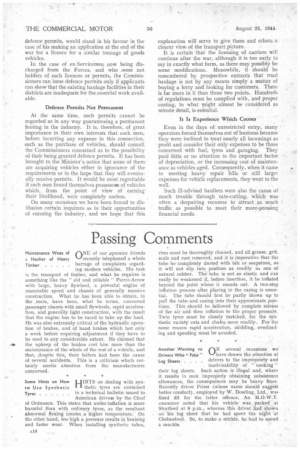Passing Comments
Page 16

Page 17

If you've noticed an error in this article please click here to report it so we can fix it.
Maintenance Woes of nNE of our operator friends a Haulier of Heavy ‘-frecently telephoned a whole
Timber barrage of complaints regard ing modern vehicles. His task is the transport of timber, and what he requires is something like the ." old and reliable " Pierce-Arrow with large, heavy flywheel, a powerful engine of reasonable speed and chassis of generally massive construction. What he has been able to obtain, in the .main, have been, what he terms, converted passenger chassis with small flywheels, rapid acceleration, and generAly light construction, with the result that the engine has to be raced to take up the load. He was also extremelycritical of the hydraulic operation of brakes, and of hand brakes which last only a week before requiring adjustment if they have to be used to any considerable extent. He claimed that
ao• the upkeep of the brakes cost him more than the maintenance of the whole of the rest of a vehicle, and that, .despite this their failure had been the cause of several accidents. This is a criticism which certainly merits attention from the manufacturers concerned.
Some Hints on How WINTS on dealing with synto Use Synthetic I thetic tyres are contained
Tyres in a technical bulletin issued to American drive by the Chief of Ordnance. This states that under-inflation is more harmful than with ordinary tyres, as the resultant abnormal flexing creates a higher temperature. On the other hand, too high a pressure results in bruising and faster wear. When installing synthetic tubes.
rims must be thoroughly cleaned, and all grease, grit, scale and rust removed, and it is imperative that the tube be completely dusted with talc or soapstone, as it will not slip into position as readily as one of natural rubber. The' tube is not so elastic and can easily be weakened if, before insertion, it be inflated beyond the point where it rounds out. A two-step inflation process after placing in the casing is essential. The tube should first be partly blown up to pull the tube and casing into their approximate positions. This should be followed by complete release of the air and then inflation to the proper pressure. Twin tyres must be closely matched, for the synthetic variety cuts and chafes more readily. For the same reason rapid acceleration, skidding, overloading and speeding must be avoided.
Another Warning to ro several occasions we Drivers Who" Fake" "—'have drawn the attention of Log Sheets , . , . drivers to the impropriety and inadvisability of " cooking " their log sheets. Such action is illegal and, where it results in men improperly obtaining subsistence allowances, the consequences may be heavy fines. ReCently driver Priest (whose name should suggest better conduct), employed by W. Dowling, Ltd., was fined 25 for the latter offence. An M.0.1iV_T. examiner noted that his vehicle was parked.: at Stratford at 8 p.m., whereas this driver had shoivii on his log sheet that he had spent the night at Chelmsford. So, to make a mickle, he had to spend a muckle.
Splendid Blood-donor Effort by Prominent Body Concern .
NAANY are the ways, outside Yz.the sphere of their direct labours, in which war workers are contributing to the national effort and a notable example of the spirit which animates many of them is to be found in the
case of Weymann's Motor Bodies, Ltd. This prominent body-building concern recently received an urgent official appeal for blood plasma, and in response, over 28 per cent, of the total personnel of the works offered and were accepted as blood donors. This public-spirited action reflects the utmost credit on the individuals concerned, but it does more than that, as it suggests. that. the employees tackle their daily war job in an atmosphere in which the will speedily to help defeat the Nazi evil is well in 'evidence.
FROM American Trucking Associations, Inc., 1424, Sixteenth Street, N.W. Washington 6, D.C., has come an excellent pictorial review entitled " Trucks Go to War." Artistically arranged and printed, mainly in two colours, this booklet contains 40 pages of photographs from the American Home Front, Italy, Africa. Near East, Far East, India, Russia, Alaska, etc., which„form ah interesting summary of the work of motor vehicles in every phase of war activity. We wish that something of this kind could be produced in connection with our commercial and military road transport. It would help to show the public what our industry 'has achieved, and is doing, and probably assist in devefoping a feeling even more favouratle to road transport. American Ha u I iers Pictorial Review of
War Effort . . .




















































